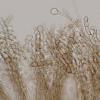
02-12-2025 18:59
This pair of ascos 2.5cm across were on recently b

02-12-2025 19:25
Buckwheat PeteHello, can anyone identify this hairy fungus growi

30-11-2025 12:53
 Edvin Johannesen
Edvin Johannesen
White short-stipitate apothecia found on thin twig

30-11-2025 10:47
 William Slosse
William Slosse
I recently found a collection of small Peziza sp.

27-11-2025 12:01
Thomas Læssøehttps://svampe.databasen.org/observations/10496727

27-11-2025 11:46
Thomas Læssøehttps://svampe.databasen.org/observations/10493918

17-09-2025 10:50
Heather MerryleesHi there!I am hoping for any advice on the identif

29-11-2025 08:40
 Andreas Millinger
Andreas Millinger
Hello,on a splintered part of a branch on the grou

28-11-2025 16:45
Nogueira HéctorNovember 23, 2025 Requejo de Sanabria (León) SPAI
Thanks again
Mal
Hi Malcolm:
is very difficult to give an opinion with only those data. Macroscopic characteristics? Asci reaction with IKI?
Dirk, your photography is a different species, perhaps G. cookeanum.
Regards.
Sabino.
Yes Dirk, but in the typical form, the parahyses of G. cookeanum can be highly variable. G. barlae ss. orig. = G. cookeanum, see Benkert.
Regards.
Sabino.
Mal
Yes Malcolm, clearly. The interpretation of Priou (and most authors) is another species.
Sabino.
Thanks Sabino
We will have to wait until all these species are included in a new key.
Mal

my key 1992 is of course obsolete after the good job by Arauzo & Iglesias. In Errotari 2014.
When I look my plate, puff! I learned to draw after... then Zorro is arrived, pardon when Zotto is arrived
At this time, , the authors for exemple Nannfelt 1942, Maas-Geesteranus 1956 and Benkert 1976 give barlae with hooked- crozier-like paraphyses. But after 1996 Benkert synonymises it with cookeanum, we need to give a new name for the specimen with such paraphyses.
In his key Sabino brings new features to separate Geoglossum species, IIK reaction and the extern cells shape of sterile part, nethertheless , with these characters, we are often "assis entre deux chaises " French lession !
JPP
I see a lot of Geoglossum cookeanum with the paraphyses consistantly multi-septate, slight constriction at the septation, and often with capitate heads. The third cell from the apex is often elongated but I have never seen it distorted as depicted in some images of the perceived G. barlae.
Regards, Chris
Mal

JPP
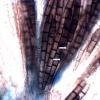
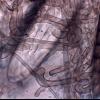
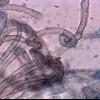
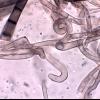

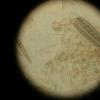
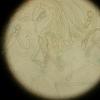
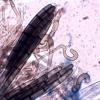
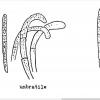
 Geoglossum barlae Benkert
Geoglossum barlae Benkert